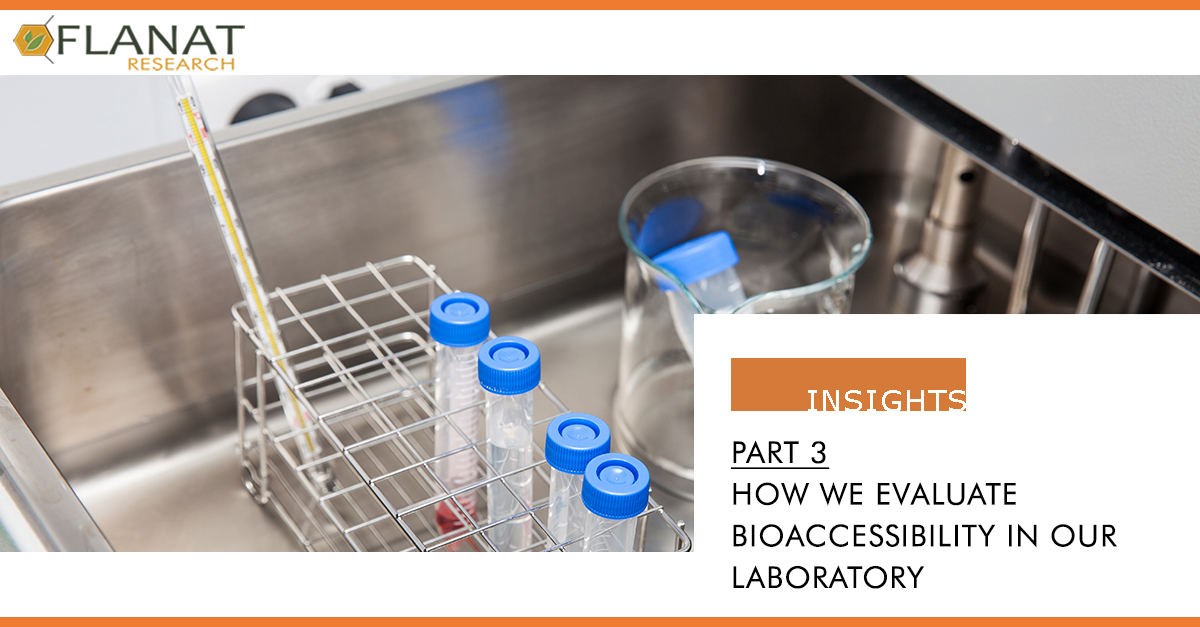Once understood that INFOGEST is the standard to follow, many companies have adopted this method to determine bioaccessibility. We, at FLANAT, have decided to follow this path to test in vitro bioaccessibility with a static method to be able to have simple studies but be able, at the same time, to get usable data for the purpose of obtaining functional and effective bioaccessible products.
We use in our R&D lab a static in vitro method, based on INFOGEST protocol, optimized by the University of Pavia IT (UNIPV chemical, toxicological and food analysis laboratory). Bioaccessibility tests are performed using an HPLC-UV-Vis analysis with the aim of determining the percentage of bioaccessibility for each phytochemicals. (Ferron L. et al. 2020)
The simulation of the digestion model is made up of several sequential phases in each of which the use of simulated digestive fluids is envisaged, consisting of stock solutions of electrolytes added in different concentrations for each phase of the digestive process. Simulated digestive fluids, i.e. Simulated Salivary Fluid (SSF), Simulated Gastric Fluid (SGF) and Simulated Intestinal Fluid (SIF) have the role of reproducing physiological digestive fluids for the oral, gastric and intestinal phases respectively.
The INFOGEST in vitro digestion protocol does not take into consideration the colon phase, which is instead studied by other experts. The model developed in 2015 by Hamzalioğlu et al. in order to better mimic the digestive process, introduced the colon phase, and modified some concentrations of the enzymes and bile salts constituting the different simulated digestive fluids. The in vitro static digestion model used in our laboratory combines all the phases together to have a complete model.
Oral phase
The first step of the oral phase is different depending on the formulation or when the food is in liquid or solid form. In the case of liquids this phase can be omitted and move directly to the gastric phase. In the case of a solid form, it is necessary to simulate the chewing process using a kitchen chopper, in order to reduce the size of the food. Only after this phase are the digestive fluids and enzymes added to simulate salivation which allows the food/formula to be lubricated to obtain the bolus. Next step is to weight the appropriate quantity of sample to be analyzed to which the SSF and α-amylase are added, the hydrolase which in the oral phase is capable of splitting the 1,4-α-D-glucosidic bonds and therefore capable of breaking down starch, glycogen and similar molecules. To simulate the oral phase as adequately as possible, the sample thus prepared is incubated in a thermostated bath and with adequate agitation to simulate passage into the mouth. (Minekus M. et al. 2014)
Gastric phase
To simulate the gastric phase in our system, the SGF, the specific enzyme and HCl are sequentially added to the sample obtained from the oral phase in variable quantities depending on the starting pH of the solution and taking into account that the purpose of the addition of HCl is to bring the pH level to a value of 3. Pepsin enzyme is also a hydrolase activated by the HCl present in the stomach capable of breaking down peptide bonds. The solution obtained, containing the sample, is incubated in a thermostated tilting bath in order to reproduce the digestion time in the stomach. (Minekus M. et al. 2014)
Intestinal phase
Once the gastric phase is over, the final sample will immediately be subjected to the intestinal phase. To simulate the intestinal environment, SIF, pancreatin and bile are added sequentially. Pancreatin is a mixture of enzymes produced by the pancreas containing α-amylase, trypsin, lipase, ribonuclease and protease, while bile is a non-enzymatic isosmotic solution that collaborates in the digestion and absorption of dietary fats. Suitable quantity of NaOH could be added to bring the solution to the intestinal pH of approximately 7. The sample is then incubated again in a tilting thermostated bath. (Minekus M. et al. 2014)
Colon phase
The colon phase, is simulated by adding colon bacterial flora proteolytic enzymes to be able to quickly and easily reproduce the environment of the large intestine. In fact, during this phase the hydrolysis of proteins and polysaccharides continues to take place in the sample and it is therefore essential to study this phase too, especially for more complex matrices. For this reason the protease enzyme, a hydrolase are added, and finally Viscozyme® L (Novozymes Corp.) is added. A more prolonged period of incubation is needed to best simulate this phase of digestion. The colon receives all material that has not been digested and absorbed in the upper portions of the gastrointestinal system and has the main function of absorbing water and electrolytes, fermenting polysaccharides and proteins, reabsorbing bile salts, and accumulating and eliminating feces. Studying this phase in an in vitro digestion protocol is also important as some lipids that should be digested in the stomach and intestine could arrive at this phase not completely digested, and therefore not absorbed. An example would be an oil-in-water emulsion surrounded by an indigestible coating, or inserted into an indigestible matrix, which cannot be completely digested by the intestine. To therefore consider the in vitro study of the digestion process complete, it is important to also consider the colon phase. (Hamzalıoğlu A. et al. 2015)
The sample is always heated at the end of each incubation phase to block the reaction of the enzymes. A centrifuge is then carried out in order to collect the supernatant, therefore everything that has passed into solution. The analyses are then performed on HPLC with the analysis method suitable for quantifying the bioaccessible actives.
Stay tuned to know in PART 4 OF 5 how bioaccessibility can be improved

